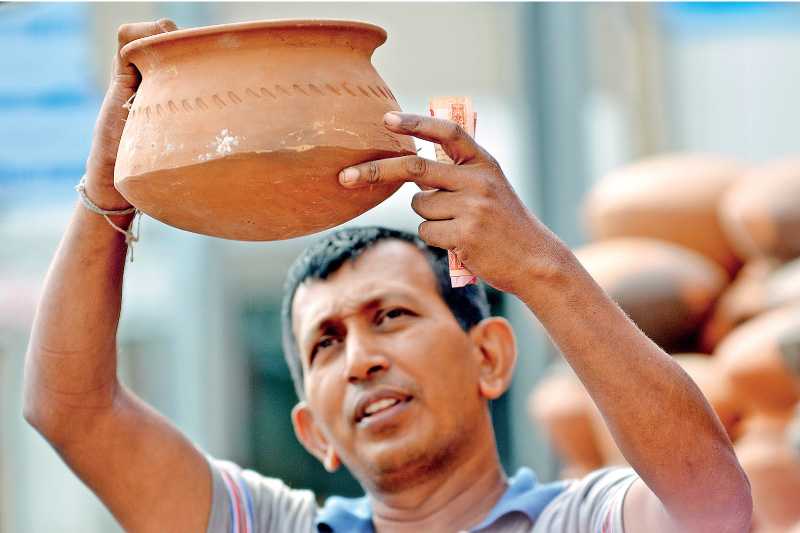Wednesday Nov 05, 2025
Wednesday Nov 05, 2025
Thursday, 25 February 2021 00:00 - - {{hitsCtrl.values.hits}}

Market is the central problem for Small and Medium scale entrepreneurs to position and survive due to quality issues and additional cost factors. However, it is the accountability of entrepreneurs to launch a quality and modern solution to win the target market – Pic by Shehan Gunasekara
 Industrialisation
Industrialisation
Industrialisation determined the rate of growth of many economies diverting from traditional agriculture to machine-driven paradigms while initiating rapid and structural changes to move in to developed trajectory. Industrialisation has transformed its expedition from the First Industrial Revolution until the Fourth Industrial Revolution today by remapping the boundaries of Global Competitiveness. More specifically, the global competitiveness has been shifted from the West to the East throughout decades.
Newly Industrialised Countries (NICs) witness the shift of global competitiveness being partners of technological revolutions in the Asian continent. https://corporatefinanceinstitute.com/resources/knowledge/economics/newly-industrialised-country-nic/. The degree of value addition is exposed as the top-secret cause behind the success. Industrialisation brought economic prosperity for economies in terms of increased gross domestic product, per capita income, export market share, employment and related other industries, etc.
Sri Lankan context of industrialisation
Sri Lanka was partially affected by the First and Second Industrial Revolutions during foreign invasions and revolutionary practices were replicated especially during the British rule. Electricity as the invention of the Second Industrial Revolution gave a new birth to locals to enhance their standards of living via consumption experience but comparatively less in terms of production processes.
I consider export oriented and import substitution as the main branches of the industrialisation. Therefore, Sri Lanka has to focus on the both simultaneously since focusing on merely one has substantial opportunity cost in terms of foreign currency. The export orientation was recently observed in the Sri Lankan industrialisation effort while neglecting the import substitution, caused uncomplimentary economic consequences such as foreign exchange depreciation, trade deficit and addicted long-term consumption patterns, etc. (Refer Annual Report, External Sector Developments, Export and Import Compositions).
Nevertheless, the apparel sector being the largest industrial gross income breadwinner has to settle its import bill for textile accessories, approximately more than 45% from its Gross Income. This mirrors the significance of value addition within the boundary in terms of domestic production. It is a true fact that none of the economies in the world are self-sufficient. As per the economics it is the comparative advantage which determines the national identity or the symbol of global competitiveness. My concern is the given-up production efforts that can be implemented within the boundary. Apart from apparel, there are sectors to be focused since apparel sector is merely on buyer’s request.
It was extremely glad to see the military weapons and armed vehicles manufactured in Sri Lanka during the Independence Day Ceremony. Certain high-tech products such as Air-Bag Pop-Up Sensor and Vega car are also position the prestige of Sri Lankans in the globe. A spare parts supplier for Old-British Morris Minor cars from southern Sri Lanka serves the market need. The recent investment on tyre manufacturing plant is appreciated in economics since it not only brings export income but also minimises import expenditure while creating multiplier effects in the economy. In parallel I regret to refer some of the import statistics which showcase unconscious abandonment of primary industries as a nation.
‘Made in Sri Lanka’ and entrepreneurial spirit
The intention writing this was originated with the title seen as ‘Made in Sri Lanka’. Apart from politics, it is a dream of all Sri Lankans to see Made in Sri Lanka at least in a few products during an era of importing commodities such as kites, cards, salt, sugar, pencils and
incense sticks, etc.
Entrepreneurial spirit is understood as one of the most important resources to influence global competitiveness during recent decades.
Entrepreneurship as an exceptional human skill is the ability to deliver human creativity in the form of an innovation to the market. Developed human thinking has driven the world towards revolutions. The contrary lack of entrepreneurial spirit has caused Least Developed Countries (LDCs) to be dependants being the market for innovations. According to Schumpeterian Creative Destruction Theory innovations due to entrepreneurship destroy existing market equilibriums and create new ones that the world is experiencing today.
Therefore, it is high time for Sri Lanka to persuade entrepreneurship as the channel of Value-Added Domestic Industries at least up to Small and Medium scale within the ongoing economic conditions to survive. It is a bitter truth that most Sri Lankan industries intensely rely on imported inputs. Therefore, the Government decision to restrict imports or imposing taxes on the same cause to contractionary effects. However, ‘Made in Sri Lanka’ will gradually create an atmosphere at least to pay attention on the areas that have been untapped.
Government sponsorship and community acceptance
National policies designed and powered by the Government being the partner of industrial growth are naturally experienced by many developed nations in the world while investing to adopt the Fourth Industrial Revolution. In case of Sri Lanka the continuous support for entrepreneurs to survive at the infant stage is indispensable in terms of institutional support with possible financial assistance. Sometimes entrepreneurs entail the recognition for their newest invention and the innovation respectively.
Market is the central problem for Small and Medium scale entrepreneurs to position and survive due to quality issues and additional cost factors. However, it is the accountability of entrepreneurs to launch a quality and modern solution to win the target market. On the other hand, shifting the mind-set of locals is also vital to boost the local demand to encourage new suppliers to the market. Therefore, Made in Sri Lanka should go hand in hand both production of commodities and mindsets of locals to be in line.
Prospects
Though the prospects and challenges are stated together traditionally, it was decided to confine the focus only on prospects as Sri Lankans anyway have to overcome challenges. The comparatively higher literacy rate of 92.5% (Annual Report, CBSL, 2019) is the key factor since the significance of implementing Made in Sri Lanka can be easily delivered. Human capital and semi-skilled labour force portion, entrepreneurial intention of youth than being an employee, economic benefits in terms of income and employment generation, Government support, the background set by the COVID and nationalistic emotions and attitudes would also be counted as prospects. I believe Made in Sri Lanka will create an era for the next generation to define Sri Lanka as a developed nation with improved standards of living and locals not interested in migrating any longer.
(The writer is a Senior Consultant/Lecturer at the School of Business, National Institute of Business Management.)